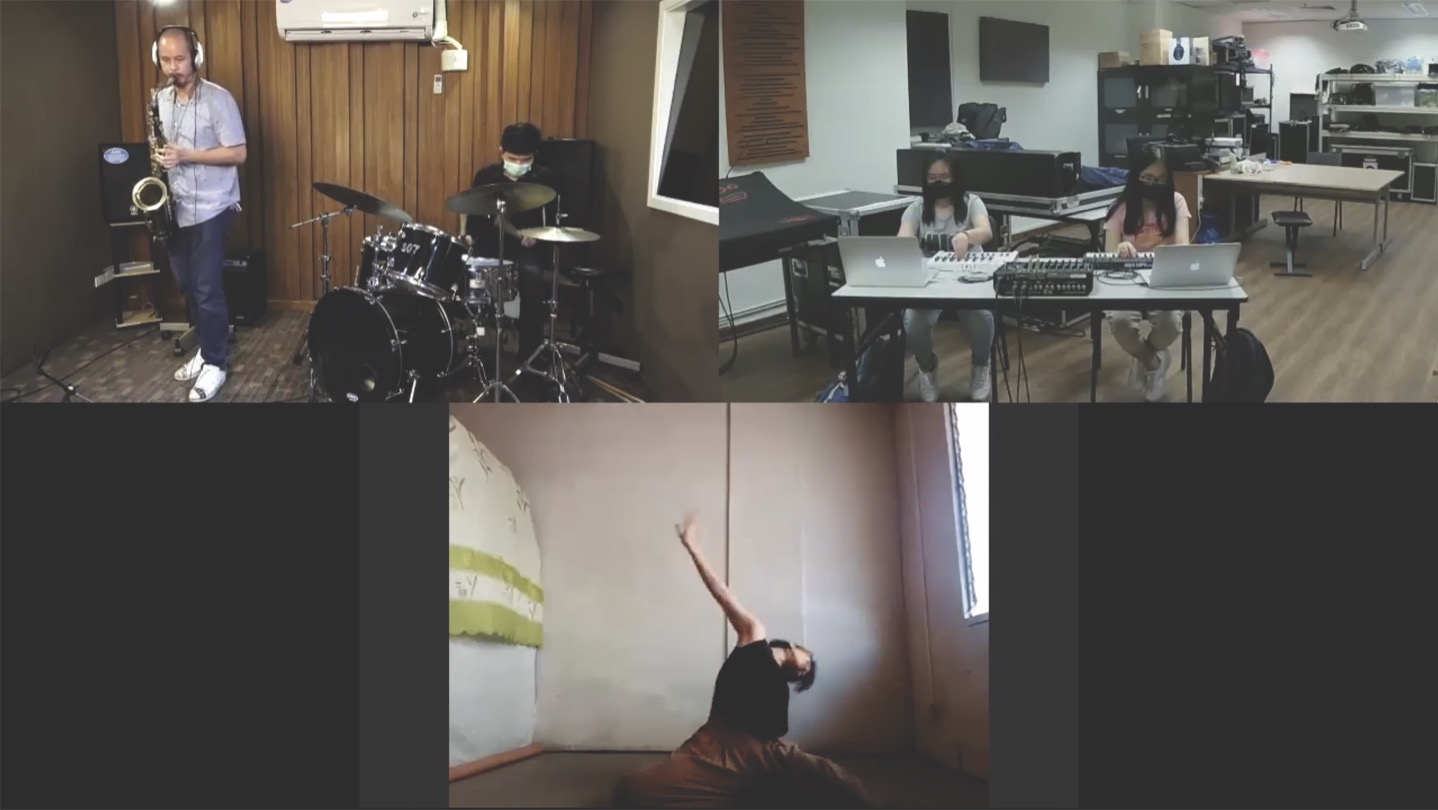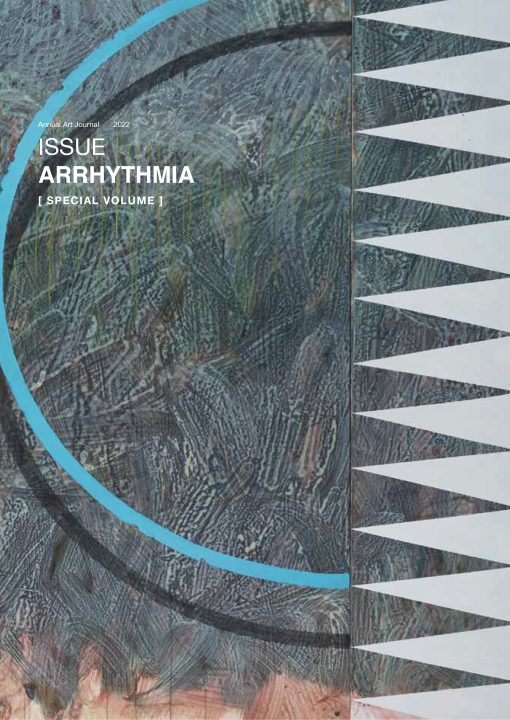The music student panel at the Arrhythmia: Performance, Pedagogy and Practice conference addressed the theme of listening and rhythmic cadence in online collaborations by staging a telematic performance. The panel featured Kla Ittitep Chummek (drums) and Hui Tonwong (saxaphone) from Silpakorn University; Rose Panuelos (dance) from the University of the Philippines; and Nadia Margawi (electronics) and Cheong Xin Ying (electronics) from LASALLE College of the Arts. The panel brought students together from different schools in the region to stage a collaboration that would feature the performers reacting in the moment —exploring ideas of rhythmic cadence, where ideas begin and end, and how performers react to each other in this latent online environment. We were especially concerned with how, with limited preparation, the group could coalesce organically and meaningfully whilst in remote locations, focussing on their abilities to listen and view each other and how they would (or not) form continuities of sound and movement.
To reflect and understand the project more intrinsically from the students’ point of view, I interviewed each of the performers after the event to capture their perspectives on the process and the performance. For Kla and Hui, this was the first time they had been involved in a telematic performance; whilst Rose had been involved in filming choreographed and improvised performances that were later presented online, but had never been in a ‘live situation’; on the other hand, Xin Ying and Nadia had already been involved in several telematic performances.
I asked the students how they prepared for the collaboration and Kla responded by saying that because he knew the music was going to be ‘abstract,’ he “found references on abstract music on YouTube and learnt from them.” For Nadia and Xin Ying, they felt confident about the collaboration so they prepared as they would for their previous performances — selecting sounds, the software and hardware that they were familiar withand knew they would use to contribute to the group. As for the dancer, Rose, she commented that,
as my only performance space was my bedroom, I had to move away a lot of things and find the best place to set up the camera…I thought about what I could explore within the area that my camera could capture.
Rose’s set-up and consideration of the visual/spatial aspect were in contrast to the musicians where their physical space was not as much a consideration. Rose’s awareness of the camera position and sense of the perspective she created with her movement within the limitations of her bedroom was also interesting. The Silpakorn students and the LASALLE students had technical support from their respective schools and performed on campus. In this situation, these students could concentrate on performing and dealing directly with information that they were receiving in real-time. Kla responded that, “as it was the first time I had played like this, I imagined how to play the music by listening to the ‘light sounds’ and watching the dancer.” Hui’s response was that:
the challenge was to try to get the other side to react to our reactions. Another challenge was that they [other performers] may not react as we expect to hear.” Nadia responded: “the challenging part was that I wasn’t performing face-to-face with the others. There were fewer facial cues so I had to rely more on my listening.”
Rose responded, “as the music was improvised, I wasn’t sure if I was disconnected or there was intended silence. I kept moving even though there was silence.”
From the perspectives of the students, the medium did pose challenges in terms of listening and reacting to each other; where one gesture would be played by musicians in Thailand and then heard, interpreted, and responded to by musicians in Singapore and vice-versa but not in the same synchronicity that would normally be possible in a face-to-face context. This disruption to sonic cadence affected how Rose reacted through her movements as she did not know what was going to be played next, creating a sense of uncertainty in the flow of her ideas. The musicians reflected a keen focus on watching Rose dance and how this shaped their decision making. The visual aspect of the performance became a focal point—a conductor—for musicians to negotiate their sense of time and cadence with the gestures. Rose, on her part, felt disengaged from the others, particularly sonically, because of the instability of her Zoom and internet connection. However, she pushed through the situation and continued to dance and contribute to the performance. For Rose: “the collaboration, being aware that you are watched, getting into the zone and thinking about nothing else but the performance. Hearing people perform live, knowing they are at the other side of the world” was inspiring in itself. For her, the collaboration, although somewhat disembodied, produced a unique experience that challenged her normal way of working.
The underlying objective of the project was to see how students would perform in an environment that would challenge their known experience of rhythmic cadence in performance. How would they confront, embrace and then develop new ways of performing through this online experience? Despite the challenges, the students were nevertheless positive about the experience and the potential of the medium. “Jazz is improvised but also in a box, but this time I tried to improvise out of the box, out of the theory,” Kla shared. Hui said, “This experience will continue to make me think out of the box when I play with other musicians.” On reflection, although exploring the idea of rhythmic cadence was a key goal of the project, it was evident that more time needed to be put into the technical aspects of the project so that the performers were not distracted/restricted by the technology itself, and could fully explore the medium with greater confidence and feel like they could take risks and interact with each other more intuitively. Rose responded: “I would probably find another location with a better internet connection. If I could do it better, maybe there would be more concepts in my performance. There could be different spaces, different settings, smaller spaces.”

Screenshot from Listening and Rhythmic Cadence telematic performance, 2021.
Photo: Tim O’Dwyer
To be more connected to each other, to refine their listening and seeing, and to enable each other to communicate on more subtle levels are all understandable desires. Through the experience, it became obvious that listening and rhythmic cadence was contingent on how much preparation time the performers had, including establishing a technologically sound environment for collaboration. Nevertheless, even with a short amount of preparation time, the performers were compelled to adapt and problem-solve, and it was evident that a heightened learning experience was created by the encounter. An interdisciplinary performance occurred and the visual aspect of the performance became the directive. The musicians adapted, improvised and created sonic connections into an overall form. The students performed with the same commitment as they would in a face-to-face situation. The students, now knowing how immediate the interaction could be in the medium, realised they were ‘closer’ to each other than before they embarked on the collaboration, and the experience opened up new possibilities for future international collaborations.


